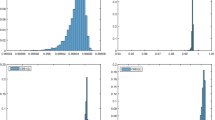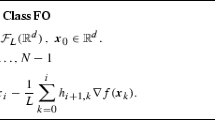Summary
An approximate Newton method, based upon the fixed point mapT, is introduced for scalar gradient equations. Although the exact Newton method coincides for such scalar equations with the standard iteration, the structure of the fixed point map provides a way of defining anR-quadratically convergent finite element iteration in the spirit of the Kantorovich theory. The loss of derivatives phenomenon, typically experienced in approximate Newton methods, is thereby avoided. It is found that two grid parameters are sssential,h and\(\bar h \approx h^2 \). The latter is used to calculate the approximate residual, and is isolated as a fractional step; it is equivalent to the approximation ofT. The former is used to calculate the Newton increment, and this is equivalent to the approximation ofT′. The complexity of the finite element computation for the Newton increment is shown to be of optimal order, via the Vituškin inequality relating metric entropy andn-widths.
Similar content being viewed by others
References
Aziz, A.K.: The mathematical foundations of the finite element method with applications to partial differential equations. London: Academic Press 1972
Bank, R.E., Rose, D.J.: Parameter selection for Newton-like methods applicable to nonlinear partial differential equations. SIAM J. Numer. Anal.17, 806–822 (1980)
Gilbarg, D., Trudinger, N.S.: Elliptic partial differential equations of second order. Heidelberg Berlin New York: Springer 1977
Hewitt, E., Stromberg, K.: Real and abstract analysis. New York: Springer 1965
Jerome, J.W.: Approximation of nonlinear evolution systems. New York London: Academic Press 1983
Jerome, J.W.: An adaptive Newton algorithm based on numerical inversion: regularization as postconditioner. Numer. Math.47, 123–138 (1985)
Jerome, J.W.: Approximate Newton methods and homotopy for stationary operator equations. Constructive Approximation1, 271–285 (1985)
Lorentz, G.G.: Metric entropy and approximation. Bull. Amer. Math. Soc.72, 903–937 (1966)
Lorentz, G.G.: Approximation of functions. Holt, Rinehart and Winston 1966
Mostefai, A.: Évaluations de l'ε-entropy dans les espaces de Sobolev. Dissertation, University of Algier 1970
Nirenberg, L.: Topics in nonlinear functional analysis. Courant Institute of Mathematical Sciences, New York University 1973–1974
Strang, G., Fix, G.J.: An analysis of the finite element method. Englewood Cliffs, NJ: Prentice-Hall 1973
Taylor, A.E.: Introduction to Functional Analysis New York: Wiley 1958
Author information
Authors and Affiliations
Additional information
Research supported by National Science Foundation grant DMS-8721742
Rights and permissions
About this article
Cite this article
Jerome, J.W. Newton's method for gradient equations based upon the fixed point map: Convergence and complexity study. Numer. Math. 55, 619–632 (1989). https://doi.org/10.1007/BF01389333
Received:
Issue Date:
DOI: https://doi.org/10.1007/BF01389333




